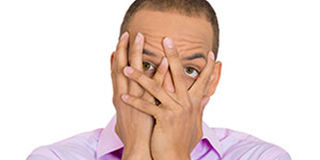How to know you’re a victim of social fears

A depiction of a man too shy to speak in public. Photo | Web
What you need to know:
Social anxiety disorder is the third largest mental health care problem in the globe.
A feeling of shyness or discomfort in some social situations is normal. For example, going on a date or giving a presentation before the mass may cause you to have that feeling of “butterflies in your stomach.”
However, when it happens everyday, it can cause significant anxiety, fear, self-consciousness and embarrassment. This is termed as Social Anxiety Disorder (social phobia).
It might be distressing affecting your daily activities, but here’s the good news; there are ways of dealing with it.
For children, anxiety about interacting with adults or peers may be shown by crying, tantrums, clinging to parents or refusing to speak in social situations.
Performance type of social anxiety disorder is said to happen when you experience intense fear and anxiety only during speaking or performing in public, but not in other types of social situations.
But you have to be aware that comfort levels in social situations vary, depending on personality traits and life experiences. Some people are naturally reserved and others are more outgoing.
How to know you have social anxiety disorder
You might be the victim if you dread everyday activities, such as meeting strangers, starting conversations, speaking on the phone, working or shopping, avoid or worry about social activities, such as group conversations or eating with company and parties.
If you always worry about doing something you think is embarrassing, such as blushing, sweating or appearing incompetent or you find it difficult to do things when others are watching you, then you are the victim.
Other signs are; if you may feel like you’re being watched and judged all the time, you fear criticism, avoid eye contact or have low self-esteem, sweaty, tremble or a pounding heartbeat (palpitations) together with panic attacks (where you have an overwhelming sense of fear and anxiety, usually only for a few minutes).
Important to note is that majority of people with social anxiety also have other mental health issues, such as depression, generalised anxiety disorder or body dysmorphic disorder (which is anxiety disorder that causes one to have a distorted view of how he/she looks and to spend a lot of time worrying about his/her appearance).
Some quick facts
Did you know that social anxiety disorder is the third largest mental health care problem worldwide today?
Large population-based surveys state that 33.7 per cent of the population are affected by an anxiety disorder during their lifetime. It typically begins in the early to mid-teens, though it can sometimes start in younger children or in adults.
How you physically appear if you experience social phobia
Blushing, fast heartbeat, trembling, sweating, upset stomach or nausea, trouble catching your breath, dizziness or lightheadedness, feeling of blank mind and muscle tension.
When to see your doctor
Have you ever thought of its impact, things that can put you into risk, complications brought about and the ways you can do away with it?
See your doctor or mental health professional if you fear and avoid normal social situations because they cause embarrassment, worry or panic.
The author is based at Hubert Kairuki Memorial University.


